+ Open data
Open data
- Basic information
Basic information
| Entry | Database: PDB / ID: 8jw0 | |||||||||||||||||||||||||||
|---|---|---|---|---|---|---|---|---|---|---|---|---|---|---|---|---|---|---|---|---|---|---|---|---|---|---|---|---|
| Title | PSI-AcpPCI supercomplex from Amphidinium carterae | |||||||||||||||||||||||||||
 Components Components |
| |||||||||||||||||||||||||||
 Keywords Keywords |  PHOTOSYNTHESIS / Photosysrem I / PHOTOSYNTHESIS / Photosysrem I /  Dinoflagellate Dinoflagellate | |||||||||||||||||||||||||||
| Function / homology |  Function and homology information Function and homology information BETA-CAROTENE / BETA-CAROTENE /  CHLOROPHYLL A / Chem-DD6 / DIGALACTOSYL DIACYL GLYCEROL (DGDG) / CHLOROPHYLL A / Chem-DD6 / DIGALACTOSYL DIACYL GLYCEROL (DGDG) /  Chlorophyll c1 / 1,2-DIPALMITOYL-PHOSPHATIDYL-GLYCEROLE / 1,2-DISTEAROYL-MONOGALACTOSYL-DIGLYCERIDE / Chlorophyll c1 / 1,2-DIPALMITOYL-PHOSPHATIDYL-GLYCEROLE / 1,2-DISTEAROYL-MONOGALACTOSYL-DIGLYCERIDE /  PERIDININ / PERIDININ /  PHYLLOQUINONE / PHYLLOQUINONE /  IRON/SULFUR CLUSTER ... IRON/SULFUR CLUSTER ... BETA-CAROTENE / BETA-CAROTENE /  CHLOROPHYLL A / Chem-DD6 / DIGALACTOSYL DIACYL GLYCEROL (DGDG) / CHLOROPHYLL A / Chem-DD6 / DIGALACTOSYL DIACYL GLYCEROL (DGDG) /  Chlorophyll c1 / 1,2-DIPALMITOYL-PHOSPHATIDYL-GLYCEROLE / 1,2-DISTEAROYL-MONOGALACTOSYL-DIGLYCERIDE / Chlorophyll c1 / 1,2-DIPALMITOYL-PHOSPHATIDYL-GLYCEROLE / 1,2-DISTEAROYL-MONOGALACTOSYL-DIGLYCERIDE /  PERIDININ / PERIDININ /  PHYLLOQUINONE / PHYLLOQUINONE /  IRON/SULFUR CLUSTER / Chem-SQD / : IRON/SULFUR CLUSTER / Chem-SQD / : Similarity search - Component | |||||||||||||||||||||||||||
| Biological species |   Amphidinium carterae (eukaryote) Amphidinium carterae (eukaryote) | |||||||||||||||||||||||||||
| Method |  ELECTRON MICROSCOPY / ELECTRON MICROSCOPY /  single particle reconstruction / single particle reconstruction /  cryo EM / Resolution: 2.9 Å cryo EM / Resolution: 2.9 Å | |||||||||||||||||||||||||||
 Authors Authors | Li, Z.H. / Li, X.Y. / Wang, W.D. | |||||||||||||||||||||||||||
| Funding support |  China, 8items China, 8items
| |||||||||||||||||||||||||||
 Citation Citation |  Journal: Proc Natl Acad Sci U S A / Year: 2024 Journal: Proc Natl Acad Sci U S A / Year: 2024Title: Structures and organizations of PSI-AcpPCI supercomplexes from red tidal and coral symbiotic photosynthetic dinoflagellates. Authors: Xiaoyi Li / Zhenhua Li / Fangfang Wang / Songhao Zhao / Caizhe Xu / Zhiyuan Mao / Jialin Duan / Yue Feng / Yang Yang / Lili Shen / Guanglei Wang / Yanyan Yang / Long-Jiang Yu / Min Sang / ...Authors: Xiaoyi Li / Zhenhua Li / Fangfang Wang / Songhao Zhao / Caizhe Xu / Zhiyuan Mao / Jialin Duan / Yue Feng / Yang Yang / Lili Shen / Guanglei Wang / Yanyan Yang / Long-Jiang Yu / Min Sang / Guangye Han / Xuchu Wang / Tingyun Kuang / Jian-Ren Shen / Wenda Wang /   Abstract: Marine photosynthetic dinoflagellates are a group of successful phytoplankton that can form red tides in the ocean and also symbiosis with corals. These features are closely related to the ...Marine photosynthetic dinoflagellates are a group of successful phytoplankton that can form red tides in the ocean and also symbiosis with corals. These features are closely related to the photosynthetic properties of dinoflagellates. We report here three structures of photosystem I (PSI)-chlorophylls (Chls) /-peridinin protein complex (PSI-AcpPCI) from two species of dinoflagellates by single-particle cryoelectron microscopy. The crucial PsaA/B subunits of a red tidal dinoflagellate are remarkably smaller and hence losing over 20 pigment-binding sites, whereas its PsaD/F/I/J/L/M/R subunits are larger and coordinate some additional pigment sites compared to other eukaryotic photosynthetic organisms, which may compensate for the smaller PsaA/B subunits. Similar modifications are observed in a coral symbiotic dinoflagellate species, where two additional core proteins and fewer AcpPCIs are identified in the PSI-AcpPCI supercomplex. The antenna proteins AcpPCIs in dinoflagellates developed some loops and pigment sites as a result to accommodate the changed PSI core, therefore the structures of PSI-AcpPCI supercomplex of dinoflagellates reveal an unusual protein assembly pattern. A huge pigment network comprising Chls and and various carotenoids is revealed from the structural analysis, which provides the basis for our deeper understanding of the energy transfer and dissipation within the PSI-AcpPCI supercomplex, as well as the evolution of photosynthetic organisms. | |||||||||||||||||||||||||||
| History |
|
- Structure visualization
Structure visualization
| Structure viewer | Molecule:  Molmil Molmil Jmol/JSmol Jmol/JSmol |
|---|
- Downloads & links
Downloads & links
- Download
Download
| PDBx/mmCIF format |  8jw0.cif.gz 8jw0.cif.gz | 1.3 MB | Display |  PDBx/mmCIF format PDBx/mmCIF format |
|---|---|---|---|---|
| PDB format |  pdb8jw0.ent.gz pdb8jw0.ent.gz | 1.2 MB | Display |  PDB format PDB format |
| PDBx/mmJSON format |  8jw0.json.gz 8jw0.json.gz | Tree view |  PDBx/mmJSON format PDBx/mmJSON format | |
| Others |  Other downloads Other downloads |
-Validation report
| Arichive directory |  https://data.pdbj.org/pub/pdb/validation_reports/jw/8jw0 https://data.pdbj.org/pub/pdb/validation_reports/jw/8jw0 ftp://data.pdbj.org/pub/pdb/validation_reports/jw/8jw0 ftp://data.pdbj.org/pub/pdb/validation_reports/jw/8jw0 | HTTPS FTP |
|---|
-Related structure data
| Related structure data |  36678MC 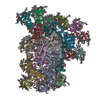 8jzeC 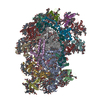 8jzfC M: map data used to model this data C: citing same article ( |
|---|---|
| Similar structure data | Similarity search - Function & homology  F&H Search F&H Search |
- Links
Links
- Assembly
Assembly
| Deposited unit | 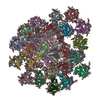
|
|---|---|
| 1 |
|
- Components
Components
-Photosystem I ... , 11 types, 11 molecules abcdefhijlm
| #1: Protein |  Mass: 70529.703 Da / Num. of mol.: 1 / Source method: isolated from a natural source / Source: (natural)   Amphidinium carterae (eukaryote) Amphidinium carterae (eukaryote) |
|---|---|
| #2: Protein |  Mass: 67962.570 Da / Num. of mol.: 1 / Source method: isolated from a natural source / Source: (natural)   Amphidinium carterae (eukaryote) Amphidinium carterae (eukaryote) |
| #3: Protein |  Mass: 9409.729 Da / Num. of mol.: 1 / Source method: isolated from a natural source / Source: (natural)   Amphidinium carterae (eukaryote) Amphidinium carterae (eukaryote) |
| #4: Protein |  Mass: 28754.719 Da / Num. of mol.: 1 / Source method: isolated from a natural source / Source: (natural)   Amphidinium carterae (eukaryote) Amphidinium carterae (eukaryote) |
| #5: Protein |  Mass: 8617.627 Da / Num. of mol.: 1 / Source method: isolated from a natural source / Source: (natural)   Amphidinium carterae (eukaryote) Amphidinium carterae (eukaryote) |
| #6: Protein |  Mass: 20761.107 Da / Num. of mol.: 1 / Source method: isolated from a natural source / Source: (natural)   Amphidinium carterae (eukaryote) Amphidinium carterae (eukaryote) |
| #7: Protein |  Mass: 14937.079 Da / Num. of mol.: 1 / Source method: isolated from a natural source / Source: (natural)   Amphidinium carterae (eukaryote) Amphidinium carterae (eukaryote) |
| #8: Protein |  Mass: 14184.242 Da / Num. of mol.: 1 / Source method: isolated from a natural source / Source: (natural)   Amphidinium carterae (eukaryote) Amphidinium carterae (eukaryote) |
| #9: Protein |  Mass: 7757.844 Da / Num. of mol.: 1 / Source method: isolated from a natural source / Source: (natural)   Amphidinium carterae (eukaryote) Amphidinium carterae (eukaryote) |
| #10: Protein |  Mass: 27994.172 Da / Num. of mol.: 1 / Source method: isolated from a natural source / Source: (natural)   Amphidinium carterae (eukaryote) Amphidinium carterae (eukaryote) |
| #11: Protein |  Mass: 9634.945 Da / Num. of mol.: 1 / Source method: isolated from a natural source / Source: (natural)   Amphidinium carterae (eukaryote) Amphidinium carterae (eukaryote) |
-Chlorophyll a-chlorophyll c-peridinin-protein-complex I- ... , 17 types, 18 molecules AGIKFJMLDBHNOTCQPE
| #12: Protein | Mass: 19554.451 Da / Num. of mol.: 1 / Source method: isolated from a natural source / Source: (natural)   Amphidinium carterae (eukaryote) Amphidinium carterae (eukaryote) | ||||||
|---|---|---|---|---|---|---|---|
| #13: Protein | Mass: 23780.170 Da / Num. of mol.: 1 / Source method: isolated from a natural source / Source: (natural)   Amphidinium carterae (eukaryote) Amphidinium carterae (eukaryote) | ||||||
| #14: Protein | Mass: 21347.398 Da / Num. of mol.: 1 / Source method: isolated from a natural source / Source: (natural)   Amphidinium carterae (eukaryote) Amphidinium carterae (eukaryote) | ||||||
| #15: Protein | Mass: 19171.273 Da / Num. of mol.: 1 / Source method: isolated from a natural source / Source: (natural)   Amphidinium carterae (eukaryote) Amphidinium carterae (eukaryote) | ||||||
| #16: Protein | Mass: 19335.070 Da / Num. of mol.: 1 / Source method: isolated from a natural source / Source: (natural)   Amphidinium carterae (eukaryote) Amphidinium carterae (eukaryote) | ||||||
| #17: Protein | Mass: 18231.799 Da / Num. of mol.: 1 / Source method: isolated from a natural source / Source: (natural)   Amphidinium carterae (eukaryote) Amphidinium carterae (eukaryote) | ||||||
| #18: Protein | Mass: 18956.426 Da / Num. of mol.: 1 / Source method: isolated from a natural source / Source: (natural)   Amphidinium carterae (eukaryote) Amphidinium carterae (eukaryote) | ||||||
| #19: Protein | Mass: 20585.494 Da / Num. of mol.: 1 / Source method: isolated from a natural source / Source: (natural)   Amphidinium carterae (eukaryote) Amphidinium carterae (eukaryote) | ||||||
| #20: Protein | Mass: 17068.318 Da / Num. of mol.: 1 / Source method: isolated from a natural source / Source: (natural)   Amphidinium carterae (eukaryote) Amphidinium carterae (eukaryote) | ||||||
| #21: Protein | Mass: 19562.781 Da / Num. of mol.: 1 / Source method: isolated from a natural source / Source: (natural)   Amphidinium carterae (eukaryote) Amphidinium carterae (eukaryote) | ||||||
| #22: Protein | Mass: 17109.432 Da / Num. of mol.: 1 / Source method: isolated from a natural source / Source: (natural)   Amphidinium carterae (eukaryote) Amphidinium carterae (eukaryote) | ||||||
| #23: Protein | Mass: 17119.342 Da / Num. of mol.: 1 / Source method: isolated from a natural source / Source: (natural)   Amphidinium carterae (eukaryote) Amphidinium carterae (eukaryote) | ||||||
| #24: Protein | Mass: 17422.854 Da / Num. of mol.: 1 / Source method: isolated from a natural source / Source: (natural)   Amphidinium carterae (eukaryote) Amphidinium carterae (eukaryote) | ||||||
| #25: Protein | Mass: 17109.498 Da / Num. of mol.: 2 / Source method: isolated from a natural source / Source: (natural)   Amphidinium carterae (eukaryote) Amphidinium carterae (eukaryote)#26: Protein | | Mass: 17357.012 Da / Num. of mol.: 1 / Source method: isolated from a natural source / Source: (natural)   Amphidinium carterae (eukaryote) Amphidinium carterae (eukaryote)#27: Protein | | Mass: 17355.807 Da / Num. of mol.: 1 / Source method: isolated from a natural source / Source: (natural)   Amphidinium carterae (eukaryote) Amphidinium carterae (eukaryote)#28: Protein | | Mass: 15280.452 Da / Num. of mol.: 1 / Source method: isolated from a natural source / Source: (natural)   Amphidinium carterae (eukaryote) Amphidinium carterae (eukaryote) |
-Sugars , 1 types, 8 molecules 
| #35: Sugar | ChemComp-DGD / |
|---|
-Non-polymers , 11 types, 403 molecules 
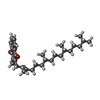





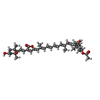
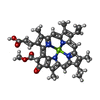










| #29: Chemical | ChemComp-CLA /  Chlorophyll a Chlorophyll a#30: Chemical |  Phytomenadione Phytomenadione#31: Chemical | ChemComp-LHG / |  Phosphatidylglycerol Phosphatidylglycerol#32: Chemical | ChemComp-BCR /  Β-Carotene Β-Carotene#33: Chemical |  Iron–sulfur cluster Iron–sulfur cluster#34: Chemical | ChemComp-LMG / #36: Chemical | ChemComp-DD6 / (  Diadinoxanthin Diadinoxanthin#37: Chemical | ChemComp-PID /  Peridinin Peridinin#38: Chemical | ChemComp-UIX / [( Mass: 642.907 Da / Num. of mol.: 12 / Source method: obtained synthetically / Formula: C42H58O5 / Feature type: SUBJECT OF INVESTIGATION #39: Chemical | ChemComp-KC1 /  Chlorophyll c Chlorophyll c#40: Chemical | |
|---|
-Details
| Has ligand of interest | Y |
|---|
-Experimental details
-Experiment
| Experiment | Method:  ELECTRON MICROSCOPY ELECTRON MICROSCOPY |
|---|---|
| EM experiment | Aggregation state: PARTICLE / 3D reconstruction method:  single particle reconstruction single particle reconstruction |
- Sample preparation
Sample preparation
| Component | Name: PSI-AcpPCI supercomplex from Amphidinium carterae / Type: COMPLEX / Entity ID: #1-#24, #26, #25, #27-#28 / Source: NATURAL |
|---|---|
| Source (natural) | Organism:   Amphidinium carterae (eukaryote) Amphidinium carterae (eukaryote) |
| Buffer solution | pH: 7.5 |
| Specimen | Embedding applied: NO / Shadowing applied: NO / Staining applied : NO / Vitrification applied : NO / Vitrification applied : YES : YES |
Vitrification | Cryogen name: ETHANE |
- Electron microscopy imaging
Electron microscopy imaging
| Experimental equipment |  Model: Titan Krios / Image courtesy: FEI Company |
|---|---|
| Microscopy | Model: FEI TITAN KRIOS |
| Electron gun | Electron source : :  FIELD EMISSION GUN / Accelerating voltage: 300 kV / Illumination mode: FLOOD BEAM FIELD EMISSION GUN / Accelerating voltage: 300 kV / Illumination mode: FLOOD BEAM |
| Electron lens | Mode: BRIGHT FIELD Bright-field microscopy / Nominal defocus max: 2200 nm / Nominal defocus min: 1500 nm Bright-field microscopy / Nominal defocus max: 2200 nm / Nominal defocus min: 1500 nm |
| Image recording | Electron dose: 50 e/Å2 / Film or detector model: GATAN K2 BASE (4k x 4k) |
- Processing
Processing
CTF correction | Type: PHASE FLIPPING AND AMPLITUDE CORRECTION | ||||||||||||||||||||||||
|---|---|---|---|---|---|---|---|---|---|---|---|---|---|---|---|---|---|---|---|---|---|---|---|---|---|
3D reconstruction | Resolution: 2.9 Å / Resolution method: FSC 0.143 CUT-OFF / Num. of particles: 356838 / Symmetry type: POINT | ||||||||||||||||||||||||
| Refine LS restraints |
|
 Movie
Movie Controller
Controller





 PDBj
PDBj















